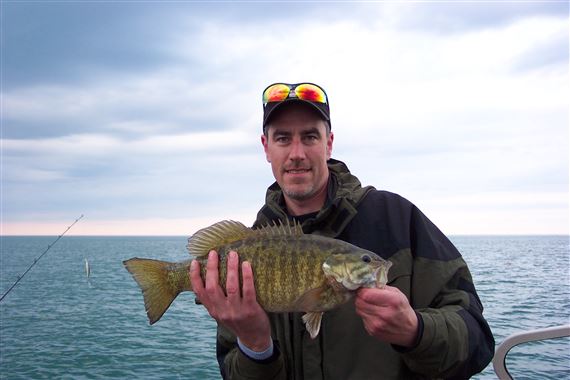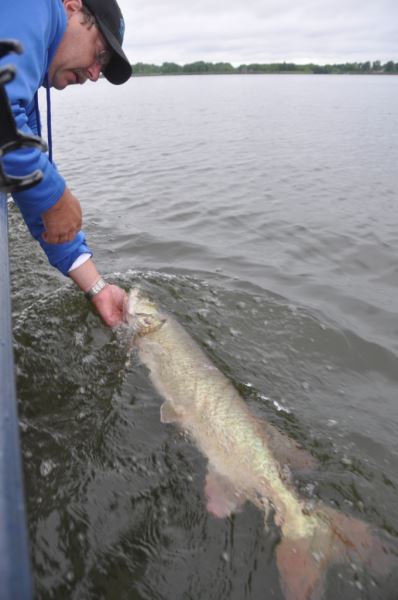
Bass-akwards as it may sound for a fishing column topic, we’re going to discuss the opposite: letting fish go—and how to do so to allow the fish to survive and thrive and perhaps be caught another day.
“Catch and release” or “C&R” is a popular practice among anglers today. The reasons vary; some gamefish species fish are sought and caught simply for the sport they offer at the end of the fishing line, and are rarely kept to eat. While many of the most popular C&R species are found in saltwater, such as bonefish, tarpon and billfish, there are some freshwater fish that are more respected for their fight than as table fare, and are often released by the anglers who pursue them. Muskellunge, pike, carp and bass are usually freed by their captors, as are trout in many areas. Some fishermen release their catches voluntarily, others are regulated to do so when wetting a line in waters that are designated as “catch and release only,” where anglers must return to the water every fish, or designated species they catch.
C&R is also practiced when anglers catch species for which the season is closed, or when the fish’s size is outside the allowable limits for keeping. For example, to assure future stocks of the popular species, several states close bass fisheries in the spring when the fish are spawning. Anglers who catch a bass at this time must immediately release it so that the fish can return to the nest and continue to protect its eggs or proceed with other activities related to spawning. Minimum, maximum and slot size limits are also imposed on some waters for targeted fish species at certain times of the year, and caught fish that fall outside of those allowable limits must be released.
The reasoning behind releasing a caught fish is to allow it to return to the population. A released fish’s capacity to do so is dependent on how healthy the fish remains after being set free. A fish that has been gut hooked, dropped on a boat deck, kept out of the water too long, or mishandled before being released isn’t likely to survive, let alone get back to assuming its intended role in the local eco-system.

Studies show that most of the released fish that don’t survive are hooked deeply and/or are handled roughly during the removal of the hook. Hooking a fish deep inside the mouth can tear the gills or puncture the gullet or stomach lining, and rough hook removal can compound the damage. That has led some experts to recommend cutting the line as close to the hook as possible on deeply-hooked fish, leaving it imbedded rather than trying to extract the hook. The argument for that method is that the metal hook would eventually rust away, or the fish’s enzymes would eat away at the metal or that tissue would grow around the hook and render it a non-issue.
Other studies have shown that simply cutting the line is not always the best a solution because hooks left behind can impede feeding and cause infection. The latest recommendation from some biologists is to do what you can to remove all hooks, even those deep inside a fish, with the absolute minimum of handling.
One of the best ways to reduce deep hooking and excessive handling in the first place is by using circle hooks when fishing with bait, which fish tend to swallow deeper than when fooled by artificial lures. Traditional J-type hooks impale a fish wherever the point comes in contact when the angler pulls on the line to set the hook—including deep in the throat. Circle hooks, on the other hand, are designed to wrap around a fish’s outer jaw structure, an area composed of bone and membranes with few blood vessels. When a fish inhales a baited circle hook and turns to run, the angler reels the line tight—not setting the hook with a yank—and the hook slides back out of the throat and catches around the edge of the jaw. Studies have even shown that the hook-up ratio with circle hooks can be higher than with J-hooks when used for species such as striped bass, catfish and several saltwater gamefish. Upon release, the circular hooks are easier to remove because the hook eye and line are already outside the fish’s mouth.
Some fly fishermen reduce release stress by using barbless hooks or crimping down on the barbs on flies tied on conventional hooks. You can do the latter with hooks used for bait fishing or on lures. Another stress-relieving tactic some anglers employ is replacing their lures’ treble hooks with single hooks.
The best advice I have to share when pursuing fish that you intend to release is to use heavy enough line and tackle to keep the fight short, so the fish doesn’t wear itself out to the extent that it may not survive once you do set if free, and to minimize the time the fish is out of the water and being handled during the release. I cut the line off and leave hooks that are deeply imbedded in a fish’s mouth, and hold fish in the water until they are recovered enough to swim out of my hands on their own. If it’s a large fish, I’ll stay in the area for a minute or two to make sure the fish can stay down on its own and doesn’t surface again; if it does, I repeat the revival process until the fish succumbs or swims off to live—and fight—another day.

